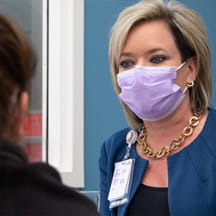In 2015, Texas Children’s Hospital made leader rounding a key initiative to improve patients’ perception of care and ensure hospital leaders were aware of quality and safety concerns on their units. Surveys by the hospital show that patients and families who receive a leader round tend to report a more favorable experience compared to those who do not.
However, the initiative was initially met with hesitation by leaders who said they lacked the skills to communicate effectively with families. To help leaders develop this skill, which is integral to a patient’s overall care and experience, a team at Texas Children’s developed a simulation-based program. The goal was to train leaders in essential communication skills and put them into practice in a real-world environment. The project team leveraged simulation to provide an immersive, hands-on and safe experience. Studies show that simulation education, using actors, helps to improve self-efficacy. It is often used as an educational tool because it mimics the real environment and can be tailored to the learning objectives.
The program has been effective. Leaders who participated have demonstrated an increased confidence and ability to have difficult conversations and improve relationships. The ease and comfort of communicating has led to greater compliance in rounding and staff connections. As a result, patients and families have reported an improved perception of team coordination and higher satisfaction with their overall care experience.
How training works
Before the simulation training, leaders complete online pre-work and participate in a two-hour teaching session. The pre-work includes information on the purpose and benefits of leadership rounding, the steps for effective leader rounding, and the principles of interpersonal communication. The teaching session reinforces the value of leader rounding; introduces resources, tools and practices to help facilitate effective leader rounding; and expands on the best practices for successful leader rounding and interpersonal communication.
Next, there are two simulations with actors depicting a scene in a real hospital environment. In the first simulation, the leaders make rounds, and the family or patient expresses concern with an element of care. In the second simulation, the leader provides feedback to a staff member based on information received in the first simulation. (See sidebar for a sample script).
Both simulations are video recorded, and simulation-trained instructor coach debriefs with the leader on what went well and what didn’t go well. The leader then completes the two simulations again, immediately applying what they learned.
The actors are staff members who volunteer, as well as Family Advisors who provide insight across various hospital activities and projects. Each scenario is scripted for the actors and for the faculty conducting the simulation, and the debriefs follow a guided template, so anyone can easily participate.
Results are in
Since training began in June 2018, 306 clinical leaders have completed the training. Participants complete a survey before and after the training indicating their ability and confidence in communicating with patients and families during rounds and coaching staff after rounds.
All measured components in the survey showed an increase in ability and confidence after the simulation. Before the simulation training, leader rounding compliance in inpatient units was at 36%. As leaders participated in training and increased their confidence and abilities, compliance increased to 55% within five months.
In addition to the data, participant feedback strongly supports the use of simulation in the training and highlights the effectiveness of the teaching method. “One of the best training experiences,” said one participant. “Very realistic scenarios that I learned from and use daily. Gave me desire to get back to rounding consistently.” Another said, “It was a very open, down-to-earth environment focused on not being punitive but just the learning process and enhancing communication through all aspects of leader rounding.”
View templates and scripts to help your team get started with leader rounding.







